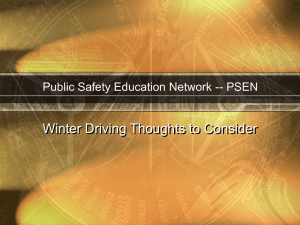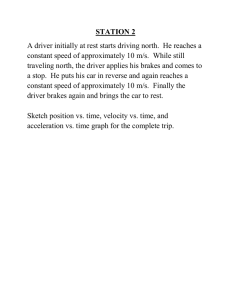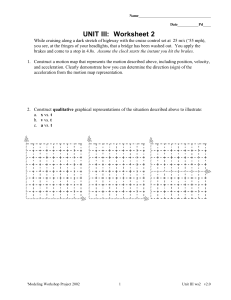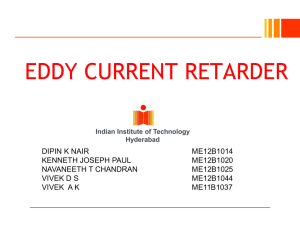IRJET- Smart Braking System (SBS) for Automobiles
advertisement
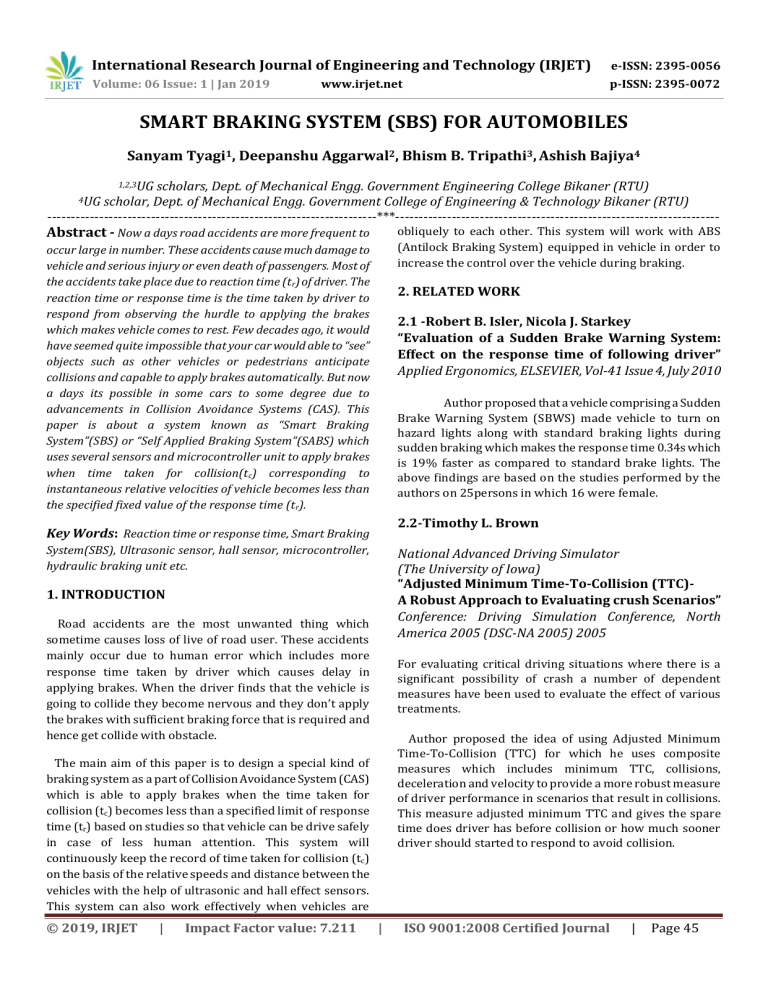
International Research Journal of Engineering and Technology (IRJET) e-ISSN: 2395-0056 Volume: 06 Issue: 1 | Jan 2019 p-ISSN: 2395-0072 www.irjet.net SMART BRAKING SYSTEM (SBS) FOR AUTOMOBILES Sanyam Tyagi1, Deepanshu Aggarwal2, Bhism B. Tripathi3, Ashish Bajiya4 scholars, Dept. of Mechanical Engg. Government Engineering College Bikaner (RTU) scholar, Dept. of Mechanical Engg. Government College of Engineering & Technology Bikaner (RTU) ----------------------------------------------------------------------***--------------------------------------------------------------------4UG 1,2,3UG Abstract - Now a days road accidents are more frequent to obliquely to each other. This system will work with ABS (Antilock Braking System) equipped in vehicle in order to increase the control over the vehicle during braking. occur large in number. These accidents cause much damage to vehicle and serious injury or even death of passengers. Most of the accidents take place due to reaction time (tr) of driver. The reaction time or response time is the time taken by driver to respond from observing the hurdle to applying the brakes which makes vehicle comes to rest. Few decades ago, it would have seemed quite impossible that your car would able to “see” objects such as other vehicles or pedestrians anticipate collisions and capable to apply brakes automatically. But now a days its possible in some cars to some degree due to advancements in Collision Avoidance Systems (CAS). This paper is about a system known as “Smart Braking System”(SBS) or “Self Applied Braking System”(SABS) which uses several sensors and microcontroller unit to apply brakes when time taken for collision(tc) corresponding to instantaneous relative velocities of vehicle becomes less than the specified fixed value of the response time (tr). 2. RELATED WORK 2.1 -Robert B. Isler, Nicola J. Starkey “Evaluation of a Sudden Brake Warning System: Effect on the response time of following driver” Applied Ergonomics, ELSEVIER, Vol-41 Issue 4, July 2010 Author proposed that a vehicle comprising a Sudden Brake Warning System (SBWS) made vehicle to turn on hazard lights along with standard braking lights during sudden braking which makes the response time 0.34s which is 19% faster as compared to standard brake lights. The above findings are based on the studies performed by the authors on 25persons in which 16 were female. 2.2-Timothy L. Brown Key Words: Reaction time or response time, Smart Braking System(SBS), Ultrasonic sensor, hall sensor, microcontroller, hydraulic braking unit etc. National Advanced Driving Simulator (The University of Iowa) “Adjusted Minimum Time-To-Collision (TTC)A Robust Approach to Evaluating crush Scenarios” Conference: Driving Simulation Conference, North America 2005 (DSC-NA 2005) 2005 1. INTRODUCTION Road accidents are the most unwanted thing which sometime causes loss of live of road user. These accidents mainly occur due to human error which includes more response time taken by driver which causes delay in applying brakes. When the driver finds that the vehicle is going to collide they become nervous and they don’t apply the brakes with sufficient braking force that is required and hence get collide with obstacle. For evaluating critical driving situations where there is a significant possibility of crash a number of dependent measures have been used to evaluate the effect of various treatments. Author proposed the idea of using Adjusted Minimum Time-To-Collision (TTC) for which he uses composite measures which includes minimum TTC, collisions, deceleration and velocity to provide a more robust measure of driver performance in scenarios that result in collisions. This measure adjusted minimum TTC and gives the spare time does driver has before collision or how much sooner driver should started to respond to avoid collision. The main aim of this paper is to design a special kind of braking system as a part of Collision Avoidance System (CAS) which is able to apply brakes when the time taken for collision (tc) becomes less than a specified limit of response time (tr) based on studies so that vehicle can be drive safely in case of less human attention. This system will continuously keep the record of time taken for collision (tc) on the basis of the relative speeds and distance between the vehicles with the help of ultrasonic and hall effect sensors. This system can also work effectively when vehicles are © 2019, IRJET | Impact Factor value: 7.211 | ISO 9001:2008 Certified Journal | Page 45 International Research Journal of Engineering and Technology (IRJET) e-ISSN: 2395-0056 Volume: 06 Issue: 1 | Jan 2019 p-ISSN: 2395-0072 www.irjet.net 2.3 -J.Ashok, V.Suganthi, I.Vijayalakshmi “Comparison of brake reaction time in younger and older drivers” International Journal of Research in Medical Sciences, Vol 4 Issue 2 February 2016 surprise events such as an object suddenly moving into the driver's path proposed by Marc Green (How Long Does It Take to Stop? Methodological Analysis of Driver perception Brake time, See Reference [1]).Then system generates a warning signal to driver. But when (tc) becomes less than (tr) (i.e. 4sec) braking system is activated and applies brakes automatically with different brake pressure for different time taken to collision(tc) ranges in accordance with database which is feed in microcontroller. SBS will be activated till velocity of trailing car (v2) become less than or equal to that of leading car (v1) and distance between them become safe distance of 4 meters. This system will also work with ABS so that driver has control on vehicle. Authors proposed that aging is also a significant factor in reaction time (tr) as age advances response time increases. On the basis of study performed by the authors on 120 persons gives the Mean value of brake reaction time 0.5282s & 0.7306s for younger (Age <55) & older (Age >55) persons respectively. 2.4-Marc Green “How Long Does It Take to stop? Methodological Analysis of Driver Perception Brake Times” Transportation Human Factors Volume 2, 2000 - Issue 3 This system will also work effectively when vehicles are obliquely to each other. SBS will also keep track record of turning radius of vehicles at different turning angles of wheel from straight forward position. For straight forward position turning radius will be infinite. This system will simultaneously check wheel angles along with tc & tr. When the object lies in the turning radius of vehicle brakes are applied. By analyzing a large number of data sets he proposed the response time for various situations such as: 1. When driver is fully aware of time and location of brake signal the response time is about 0.70 to 0.75sec. 2. In case of unexpected, but common signals such as a lead car's brake light is about 1.25sec. 3. For surprise events such as an object suddenly moving into the driver’s path is roughly 1.5 sec. However these times are affected by some other factors such as driver's age, gender, cognitive load and urgency. This system will work only when the relative velocity (Vrel) is 55km/h or higher so that driver can drive vehicle in traffic without any irritation. Thus this system will apply brakes by anticipating collision when above three conditions are simultaneously followed (i.e. Tc<Tr, object is in turning radius of vehicle & Vrel>= 55km/h). 2.5--A. H. Ingale, Rajesh Kumar Bambal, Sanchay Shobhane “Intelligent Braking System” IJRISE Vol 3, Issue 2, March -April – 2017 This system also gives real time information by three Leds of green, yellow & red color informing about safe zone, warning zone and collision prone zone respectively. Author proposed an idea by which vehicle is able to apply brakes using ultrasonic sensors and microcontroller by keeping the record of vehicle Speed, Distance between vehicles and the feed values of braking distances at that speed. 4. ALGORITHM 3. METHODOLOGY V1 Velocity of leading car This smart Braking System (SBS) comprises of ultrasonic sensors, Hall Effect sensors, microcontroller unit (Arduino Uno) with Bluetooth module. V2 Velocity of trailing car SBS works by keeping the track of time taken for collision (tc) at every instant calculated by microcontroller using distance between two vehicles (d) and their relative velocities (Vrel). t’c actual time taken for collision When (tc) becomes equal to the fixed value of response time (tr) that is 4 sec which is more than twice that is in case of i1, i2, i3, i4 are braking force intensities in increasing order © 2019, IRJET | Impact Factor value: 7.211 Notations: Vrel Relative velocity of leading car with respect to trailing car tc absolute time taken for collision tr reaction time or response time. d distance between two cars | ISO 9001:2008 Certified Journal | Page 46 International Research Journal of Engineering and Technology (IRJET) e-ISSN: 2395-0056 Volume: 06 Issue: 1 | Jan 2019 p-ISSN: 2395-0072 www.irjet.net Vrel = V1-V2= d/tc tc = d/( V1-V2) set tr = 4sec Check Vrel then Fig -1: Leading & Trailing cars separated by distance‘d’ are shown. Ultrasonic waves are reflecting back to trailing car from the leading car. Compare tc & tr 5. DESCRIPTION OF COMPONENTS If tc > tr (turn Green Led safe Zone) 5.1 Ultrasonic sensor If tc =tr (Give warning by yellow led.) These sensor are comprises of ultrasonic wave transmitter which transmits ultrasonic waves of 40 kHz frequency and the receiver which receive the reflected wave from obstacle. The ultrasonic waves have property that they are not much affected by climatic and weather conditions. On the basis of time taken by ultrasonic waves to get reflected back the distance between vehicle and object can be determined. if Vrel >55km/h (Otherwise do not initiate smart brake system) if tc < tr tc = -t’c Then Check wheel turning angle and check the value of corresponding turning radius from database. If it is in turning radius Now we have two ways to calculate the relative velocity of two vehicles one is by emitting ultrasonic waves successively in very short intervals of time say after 0.01 sec. When these distances are in per unit time then there difference will give relative velocities of vehicle as generally all the speeds shown by speedometer are in per hour. Then 5.2 Hall Effect sensor & Bluetooth module- Apply brake with suitable pressure as feed in microcontroller for that range of t’c & turn Red Led on (collision prone). This way of measuring speed is by measuring the speed of two vehicles individually with the help of Hall Effect sensors & sending it to the each other by Bluetooth module and from these individual velocities using suitable programme microcontroller can calculate relative velocities and finally time taken for collision (tc). Check whether object or another vehicle is in the turning radius of the vehicle or not? (If object is in turning radius then initiate braking system otherwise do not) If t’c.= 4s – 3s apply brakes by intensity i1 t'c.= 3s – 2s apply brakes by intensity i2 5.3Hall SensorIt is a transducer that varies its output in response to the changes in magnetic field density. These are used for proximity switching, positioning speed detection. t’c.= 2s – 1s apply brakes by intensity i3 t’c<1s apply brakes by intensity i4 (full pressure) 5.4 Bluetooth module (Hc-05) Braking until V2 <V1 or V2=V1 & check if d>4m or d= 4m. HC‐05 module is an easy to use Bluetooth SPP (Serial Port Protocol) module, designed for transparent wireless serial connection setup. The HC-05 Bluetooth Module can be used in a Master or Slave configuration, making it a great solution for wireless communication. This serial port Bluetooth module is fully qualified Bluetooth V2.0+EDR (Enhanced For true continue at V2 if false retard till ‘d’ becomes greater than equal to 4m & then continue with v2. © 2019, IRJET | Impact Factor value: 7.211 | ISO 9001:2008 Certified Journal | Page 47 International Research Journal of Engineering and Technology (IRJET) e-ISSN: 2395-0056 Volume: 06 Issue: 1 | Jan 2019 p-ISSN: 2395-0072 www.irjet.net Data Rate) 3Mbps Modulation with complete 2.4GHz radio transceiver and baseband. It uses CSR Bluecore 04‐External single chip Bluetooth system with CMOS technology and with AFH (Adaptive Frequency Hopping Feature). as ultrasonic waves are less affected by environmental conditions. As system will work with ABS (Antilock Braking System) which makes driver’s control over vehicle during braking and provide a comfortable drive. 5.5 Arduino UNO- REFERENCES Arduino is an open-source platform used for building electronics projects. Arduino consists of both a physical programmable circuit board (often referred to as a microcontroller) and a piece of software, or IDE (Integrated Development Environment) that runs on your computer, used to write and upload computer code to the physical board. The Arduino does not need a separate piece of hardware (called a programmer) in order to load new code onto the board – you can simply use a USB cable. Additionally, the Arduino IDE uses a simplified version of C++, making it easier to learn to program. Finally, Arduino provides a standard form factor that breaks out the functions of the micro-controller into a more accessible package. 1) Marc Green, "How Long Does It Take to Stop?" Methodological Analysis of Driver Perception-Brake Times, Transportation Human Factors, Volume 2, 2000 Issue 3. 2) J. Ashok, V. Suganthi, I. Vijayalakshmi, “Comparison of brake reaction time in younger and older drivers” International Journal of Research in Medical Sciences, Volume 4 Issue 2 February 2016. 3) Timothy L Brown, “Adjusted Minimum Time-ToCollision (TTC): A Robust Approach to Evaluating Crash Scenarios, Conference: Driving Simulation Conference, North America 2005 (DSC-NA 2005) 2005. 4) 5.6 Hydraulic Braking Unit Hydraulic braking unit comprises electronic control unit and Master and slave cylinders along with hose pipes and brakes either drum or disc brake. Hydraulic brake unit has incompressible fluid filled in the cylinder which is used to apply the pressure on wheels with less effort. Isler RB, Starkey NJ, “Evaluation of a sudden brake warning system: Effect on the response time of the following driver, Applied Ergonomics, Volume 41, Issue 4, July 2010. 5) Rafał S. Jurecki, Marek Jaśkiewicz, Marek Guzek, Zbigniew Lozia, Piotr Zdanowicz, “Driver’s reaction time under emergency braking a car Research in a 6) driving simulator”, Eksploatacja I Niezawodnosc Maintenance and Reliablility Volume 14 No.4, 2012. 7) Pamela Maria D’Addario, “Perception-Response Time to Emergency Roadway Hazards and the Effect of Cognitive Distraction”, Thesis work for the degree of Master of Applied Science Department of Mechanical and Industrial Engineering, University of Toronto. 8) A. H. Ingle , Rajesh Kumar Bambal, Sanchay Shobhane, “INTELLIGENT BRAKING SYSTEM”, International Journal of Research In Science & Engineering, Volume: 3 Issue: 2 March-April 2017 9) Ashwin Francis, Abel Antoo, Jerald John, Augustin Sagar, Sreejith K, “INTELLIGENT BRAKING SYSTEM FOR AUTOMOBILES”, International Research Journal of Engineering and Technology (IRJET), Volume: 05 Issue: 03 | Mar-2018 Fig -2: Circuit Diagram 6. CONCLUSION SBS has large potential in avoiding collisions up to greater extent & can also able to reduce their severity. It can be considered as a powerful safety tool for automobiles. By SBS it is made possible to drive a car with less human attention. This system can be a milestone in preventing the train accidents too in case when trains are running on the same track. This system can also work in bad weather conditions © 2019, IRJET | Impact Factor value: 7.211 10) DAWN Newspaper, https://www.dawn.com/news/ 743542 11) WHO Traffic injuries, https://www.who.int/newsroom/fact-sheets/detail/road-traffic-injuries | ISO 9001:2008 Certified Journal | Page 48 International Research Journal of Engineering and Technology (IRJET) e-ISSN: 2395-0056 Volume: 06 Issue: 1 | Jan 2019 p-ISSN: 2395-0072 www.irjet.net 12) Wikipedia, Bluetooth module HC-05( eprolabs), Ardriuno Uno etc ABOUT AUTHORS Sanyam Tyagi Pursuing B.Tech in Mechanical Engineering, Govt. Engineering College Bikaner, Rajasthan. Email:sanyamktyagi@gmail.com Deepanshu Aggarwal Pursuing B.Tech in Mechanical Engineering, Govt. Engineering College Bikaner, Rajasthan. Bhism Baijnath Tripathi Pursuing B.Tech in Mechanical Engineering, Govt. Engineering College Bikaner, Rajasthan. Ashish Bajiya Pursuing B.Tech in Mechanical Engineering, Govt. College of Engineering & Technology Bikaner, Rajasthan. © 2019, IRJET | Impact Factor value: 7.211 | ISO 9001:2008 Certified Journal | Page 49
